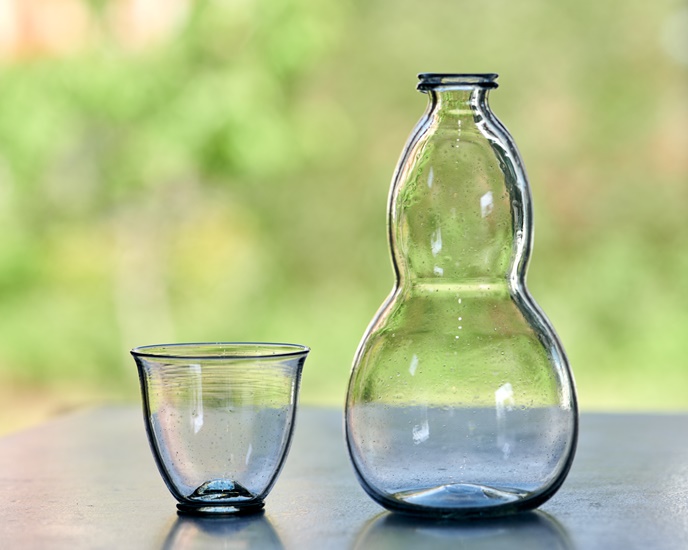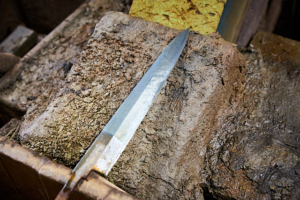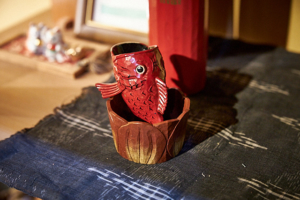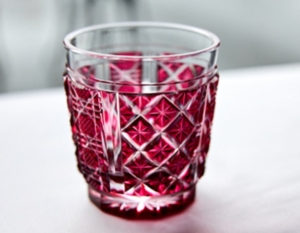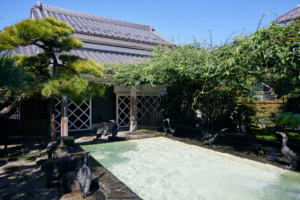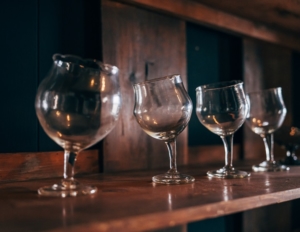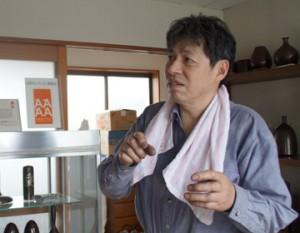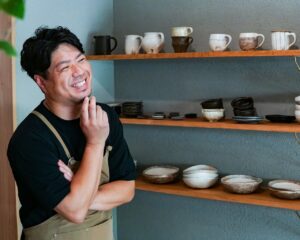The grayish color is reminiscent of antiques, and the sophisticated appearance fits in with modern life. Glass artist Kenichi Sasagawa’s vessels have attracted attention in Japan and abroad for their style, but he says that his original work was art. How did he arrive at his current style?
Guided by “intuition,” he went from art school to becoming a glass artist.

A native of Kanagawa Prefecture, Mr. Sasagawa first began making glass while a student at Tama Art University’s Department of Crafts. At the time when she applied for the entrance exam, she had to choose between glass and metal as her major when submitting her application, and she recalls that she chose glass on a hunch. Glass is beautiful, and he had a hunch that the certain “inconvenience” of working with tools would suit his taste.
The works he produced at art school were different from his current style, Sasagawa recalls. At that time, I was making colorless and transparent glass works, not colored glass, and I was creating objects and installations. He also used materials commonly used as raw materials for glass, such as silica sand, which is made by grinding quartz, a highly transparent mineral, into a sand-like consistency, and lime, which is added to glass to prevent it from dissolving in water.
Many of his seniors and advisors in the laboratory where he was enrolled at the time were active as artists, holding solo exhibitions, and Mr. Sasakawa entered graduate school with the aim of becoming an artist himself. While in graduate school, he won the Encouragement Prize at the “International Exhibition of Glass Kanazawa 2004,” was selected for the “New Glass Review26” organized by the Corning Museum of Art in the U.S. in 2005, and was selected for the “2nd Contemporary Glass Grand Prize Exhibition in Toyama 2005,” among many other domestic and international competitions. He has been selected in numerous domestic and international competitions.
After completing his master’s program, Mr. Sasakawa relocated to Kanazawa City, Ishikawa Prefecture, in search of an environment where he could have more contact with glass. He spent two years as a trainee at the Utatsuyama Craft Workshop in Kanazawa, which fosters leaders in a wide range of crafts, including ceramics, lacquerware, dyeing, metalwork, and glass.
The days of Utatsuyama Craft Workshop taught me the “beauty of use
At art school, Sasakawa mainly made objects, keeping in mind “how to showcase the material of glass,” but the demands of art school, which emphasized high artistic quality, were different from those of Utatsuyama, which emphasized everyday and practical use. Mr. Sasagawa recalls that his previous style, which was highly artistic, often failed to communicate with the specialists who provided guidance at Utatsuyama and with his fellow trainees. This situation of “not being able to communicate through his artwork” led Mr. Sasakawa to seek a different method of expression.
In his search for a form of expression that would reach a wide audience, Mr. Sasagawa noticed the beauty of the city of Kanazawa. In this city, where traditional crafts and the aesthetics of the tea ceremony culture existed on a daily basis, Mr. Sasagawa opened his eyes to the charms of Japanese culture, and subsequently deepened his interest in the world of crafts and the “beauty of use. In Kanazawa, there were many opportunities to participate in various art events and exhibitions and sales, and he had several opportunities to make practical vessels in response to requests to exhibit his work. Through these experiences, his interest shifted from the sharp expression he had aimed for while in college to the casual beauty of daily life, and he gradually shifted his focus from making objects to making vessels.

The work “Utsuwa no koto” (2007), created while Mr. Sasagawa was working at Utatsuyama Kogei Kobo (Utatsuyama Craft Studio), is a work that examines the difference between looking at vessels and looking at art, and won the Excellence Award at the 3rd Contemporary Glass Grand Prize Exhibition in Toyama 2008. This group of works, consisting of objects reminiscent of earthenware from ancient civilizations, is an important work that symbolizes a turning point for Mr. Sasakawa.
The inspiration for his works came from his visits to various museums and art galleries in Kanazawa, both large and small. Born and raised in a new town in Kanagawa Prefecture, Sasakawa was interested in contemporary art at university, but he eventually came to incorporate the essence of “history and tradition” into his works, something he had regarded as somewhat negative at the time.
Own your own kiln in a small town located in the middle of Kyoto and Nara

In 2008, after completing his two years at Utatsuyama Craft Workshop, Mr. Sasagawa returned to Kanagawa Prefecture to spend four years from 2010 when he was offered a post as an assistant at Tama Art University, his alma mater, after working as an artist in Hokuriku.
During that period, Sasakawa worked hard at creating works while borrowing a kiln from his senior’s studio, a kiln at his workplace at Tama Art University, and a kiln at a rental studio, but gradually his desire to own his own kiln grew stronger.
However, he gradually became more and more interested in “owning my own kiln.” When he rented a kiln, the glass he could use was limited to common glass, which was mainly colorless, transparent glass. Sasagawa felt that such “clean” glass was unsatisfactory. He wanted to make his own fabrics to match his own style, as his fellow ceramic artists at Utatsuyama Kogei Kobo had done. At that time, an acquaintance introduced him to a property in Ide-cho, Kyoto Prefecture, far from his hometown, and he moved there in 2016. Located between the two ancient capitals of Kyoto and Nara, the town has a population of about 7,000 in the southern part of Kyoto Prefecture. For Mr. Sasagawa, who grew up in the city, the quiet environment surrounded by the nature of a mountain village is refreshing and he likes it very much.
Having his own kiln here, Mr. Sasagawa has been able to complete his one-of-a-kind pottery, which has been well received both in Japan and abroad.
Wine glasses and sake cups. Vessels made of recycled glass with delicate bubbles.

At his studio in Ide-machi, Mr. Sasakawa has completed a variety of everyday vessels, such as glasses and sake cups, made from “recycled glass.
Reclaimed glass is made by melting glass cullet, which is a crushed piece of waste glass, at high temperature. Mr. Sasagawa uses used fluorescent tube cullet as the material for his works. Incidentally, the reason why he paid attention to recycled glass is because he had many opportunities to recycle glass when he was working as an assistant. Recycled glass has a light blue color because the tips of the iron rods used in the production process stick to the raw glass material. He wanted to make use of this color in his work. Another reason was that he felt the antique-like texture of recycled glass had a “modern” feel.
The color of Sasagawa’s vessels is an exquisite nuanced grayish-blue, created by adding oxidized metals such as cobalt and copper to the original color of recycled glass in a unique blend. At the same time, he is also particular about the “lightness of color. Since Mr. Sasakawa himself is an alcoholic beverage lover, he made repeated adjustments to achieve a color that would make drinks look delicious.
In addition, the process of making recycled glass tends to produce air bubbles, which are trapped inside the glass. The glass is made in accordance with the artist’s own sensibility: “Glass without bubbles is beautiful, but I feel that it is a little lacking.
Thinness of the fabric that enhances the exquisite colors

Another appealing feature of Sasagawa’s vessels is their thin texture. He says that he arrived at this thinness because he has always preferred sharp forms to thick ones, and the combination of the thin fabric and the grayish-blue color of the recycled glass creates an exquisite effect.
The light-colored glass gives a sense of depth when you look into a vessel because the color accumulates around the edges, but the thin fabric gives a crisp, sharpened impression. It also goes without saying that a thin fabric glass or cup enhances the delicate flavor of the beverage because it is less uncomfortable when it touches the lips.
The thinness requires considerable skill and temperature control, and the most important thing is to make sure that the utensils are hot enough. These efforts have resulted in the creation of exquisitely textured vessels that are highly regarded as one-of-a-kind.
Popular both at home and abroad. The “scenery” interwoven with the food and beverages is also an attraction.

After spending his days at Utatsuyama in Kanazawa, Sasagawa’s gray-blue vessels were completed at his studio in Ide-machi. He says that he arrived at the present style with the intention of “creating vessels that glow beautifully even in the weak light of Kanazawa in winter.” The color of the vessels looks like the color of the sky of the Sea of Japan region in winter, which is filled with rain and snow grains.
The great appeal of permeable glass is that it changes its expression depending on the light. In addition, glass vessels create a view inside the vessel while echoing the food and beverages served in them. Sasakawa’s vessels, which are favored both domestically and internationally, are sure to bring happiness to the daily lives of those who use them, creating various landscapes that resonate with the light and the delicacies of different climates.



